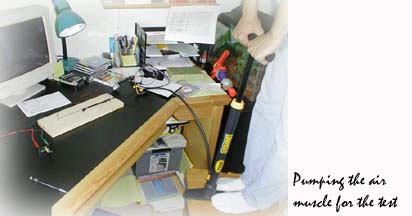


We found several books on various digital projects at our local library that helped us plan our project and offered invaluable advice on good construction methods. In the above picture, Bryce reads from one of those books as he assmbles a parallel port plug.

The above pictures are a test we did of the air muscle. When air muscles are working properly they will, contract in length and expand in diameter when air is pumped into them. The air is controlled using a solenoid valve which is in turn controlled via electric switch. More detailed information about the use of air muscles can be found at the Images Company Website or at the Shadow Robot Group.

We learned that the type of air compressor that would be ideal for this project costs approximately $400.00 and its auditory violence is at cross purposes with our goal of a display product. The reason the ideal air compressor is so expensive is because it needs to store air and then shut off its motor when adequate pressure levels are established.
This is required to provide constant, continous air pressure to the system. This is necessary for many air muscle movements to be iniated and performed smoothly. Less expensive air compressors do not provide the air storage feature and do not provide automatic air cutoff.

The solution that we found to this problem was purchasing an inexpensive bicycle hand pump to provide the air necessary for the air muscles. This doesn't provide a constant flow of air, but it is cheaper, lightweight and portable, and adequate for demonstration purposes. It does supply a shut-off mechanism... stop pumping. The availability of this resource at your local Fred Meyers gives interested students inspiration with items they can find in their own backyard; showing the practical applications of engineering and encouraging home experimentation.
